What do root vegetables, horseshoes, the groundhog and the Celtic Goddess Brigid have in common? They’re the ingredients of two mid-winter rituals I want to share with you.

Photo by Abigail Lynn for Unsplash
I live in Connecticut. Winters are long and cold. In early February, folks look to the groundhog to predict the coming of spring. Early on February 2, he pops up from his underground den. If he sees his shadow, it’s because the sun is weak. It hasn’t risen high enough to warm the land. We can expect six more weeks of winter. If he doesn’t see his shadow, the sun is strong and has already risen high enough to begin warming the land. Spring will come early. Instead of consulting the groundhog, my Celtic ancestors looked to the Goddess Brigid for signs of spring.
Let me set the scene. It’s mid-winter. Even though we have snow on the ground, we can see and feel an increase in light. The Sun is warming Mother Earth. We can see a few early signs of spring. Sure, the trees are still bare but that makes it easy for birds of prey to spot mice, squirrels, and small birds. This is when the hawks have their babies.

Sun on snow – Photo by Jon Stutfield for Unsplash
Ever since the Winter Solstice of last December, the days have grown longer. We can see the difference. We can feel the difference. Teased by one brief spell of warm weather and we feel a surge of energy. Something inside us stirs. At the same time, life underground quickens in the roots. For months, some part of us has been hibernating and now we feel eager, hopeful, and restless.
A Simple Ritual with Root Vegetables
A simple ritual for mid-winter is to connect with food that grows under the ground, absorbing the nutrients in the soil. Gather root vegetables — potatoes, onions, carrots, beets, yams, parsnips, and more. As you prep the vegetables for a meal, think about the nutrients they provide and the magic they represent. Here are three examples.
The Magic of Potatoes and Sassy Spud Girl: There was a time when potatoes, members of the nightshade family, were thought to be poisonous. Many meals later, that idea proved false. Thank goodness! Loaded with vitamins B6 and C, as well as potassium, magnesium, and other good things, there’s a lot to love about the spud. Cut a potato into pieces and each one is capable of generating new life.
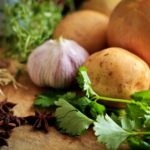
Potatoes, onions and more ready for soup – Photo by Syd Wachs for Unsplash
For many years, what we think of as the humble potato was an essential crop in Ireland. It was a favorite in Lithuania, too. In his book, A Compendium of Herbal Magick, author Paul Beyerl talks about the Lithuanian potato harvest and the ritual of honoring the one who digs up the last potato by naming her “Old Potato Woman.” Beyerl also talks about the honor given to potatoes in Peru. There, the tuber has its own spirit. She’s called Axo-mama.
The next time you prep potatoes, do this simple ritual. Cut the potato and say, “Thank you for your life-giving spirit.” When you eat the potatoes, thank those once called “Old Potato Woman.” Claim the title for yourself. Or claim a title of your own choosing. I like “Sassy Spud Girl.”
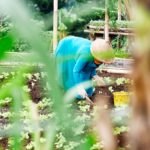
Woman tending garden – Photo by Eggy Gouztam for Unsplash
The Magic of Carrots and My Sister Eileen: My sister Eileen is a master gardener. She always has a big garden and every seed she plants always grows twice. One year, she rimmed her garden with a two-story layer of cinder blocks. Into both holes of each block she planted carrots. Not having tried this form of planting before, she wasn’t sure of how it would turn out. So she planted not one but several carrot seeds in each hole. You can guess what happened. She had a bumper crop! The carrots grew so big they filled the holes right to the edge. My husband and I helped her pull them out. I think some of the roots ran all the way to China.
Therein lies some of the carrot’s magic. Freeing them from the soil builds strength and works up an appetite. Succeeding gives a feeling of confidence. The shape of the carrot suggests fertility for your efforts. There’s another reward, too. If you’ve never tasted a carrot just pulled from the earth and rinsed with the garden hose, you’re missing one of life’s pleasures.
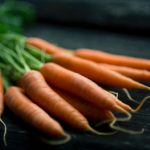
Fresh carrots – Photo by Jonathan Pielmayer for Unsplash
The next time you cook carrots, say, “I’m grateful for the will power, strength and confidence you offer.” If you’re so inclined, you can also say, “May your power fertilize the wish in my heart.”
The Magic of Onions and My Grandmother Katy: In the early 1900s, my grandparents homesteaded on the Dakota Territory. They had to be self-sufficient and that included making their own medicine. When my dad reminisced about his childhood, he often talked about the pot of onion syrup that sat on the kitchen stove all winter. My grandmother Katy swore by her goopy cure-all. She lived into her 90s. I can’t say her onion syrup had anything to do with it but I do know onions have long been valued for their healing properties. In fact, years ago people believed that simply cutting an onion in half and leaving it in a room would absorb sickness. The National Onion Association points to the onion’s ability to reduce the risk of developing gastric ulcers, trigger insulin production, and regulate blood sugar. And then there’s the poetic reflection on the skin-thin layers of an onion, and how the truth of a matter is revealed as each layer is peeled away.
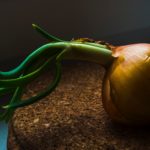
Onion with green stem – Photo by Tobias Macha for Unsplash
Next time you’re peeling and chopping onions, don’t get upset if they make you cry. Instead, say “These are tears of gratitude. Thank you for supporting my health and my authenticity.”
Whatever root vegetables you use, keep in mind that a ritual is a visible act performed with invisible intent. The invisible intent with this simple root ritual is to be nourished by the magic of the vegetables. The visible act is to eat the vegetables.
Imbolc – a Celtic Mid-Winter Ritual
Imbolc is an old, old Celtic solar festival held in early February, when the Sun reaches the middle of the fixed sign of Aquarius. Imbolc celebrates the fulfillment of the promise made at the Winter Solstice. Light has returned.
My Celtic ancestors would have celebrated Imbolc with the Goddess Brigid, also known as Bride, or Breed, and eventually as St. Bridget. In Greek mythology, this is when the Goddess Persephone lights her lamp in the Underworld and begins her journey upward. She’ll arrive on the Spring Equinox. In Scandinavian countries, the festival of lights features a girl who wears a crown of candles. The girl is known today as St. Lucy. In New England, the most recognized symbol of the season is the groundhog.
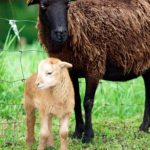
Sheep and lamb – Photo by Monica Obando Molina for Unsplash
The word “imbolc” means “in the belly” or “in the milk” and refers to the many pregnant ewes, more visible evidence that spring is on the way. Pay attention and you’ll discover other signs of spring, too: the chirping of birds, more animal tracks in the snow, increased activity from birds of prey, growing physical energy, and for some of us, an instinct to clean house!
Keeper of knowledge, the Celtic Goddess Brigid is the alchemist calls us to her sacred well. In the water we see our reflection and the burdens we carry. We’re invited to lay our burden down, tell our story, rekindle our inner fire, and be healed.
For several years, I’ve conducted an Imbolc ritual at Meg’s Inspirations, a local, spiritual boutique in Manchester, CT. The most recent ritual focused on Brigid in her three forms: Goddess of Healers, Smithcrafters, and Poets.
As the Goddess of Healers, Brigid knows the power of earth and water. Water quenches thirst, soothes aches, cleanses wounds, washes away what we no longer wish to carry – what we no longer can carry. She knows that flood water can destroy and that womb water can protect.
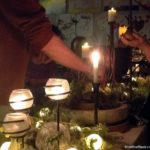
A man sprinkles dried herbs on the water of Brigid’s healing well
Brigid knows the healing power of herbs, one of many gifts from the earth. If you lived in times gone by, you’d see Brigid in deep wells and dark pools, in plants growing wild in meadows and forests, and hanging in bundles from the cottage rafters to dry. During the ritual, each of us sprinkled dried herbs on the water in a birdbath, re-imagined as one of Brigid’s sacred wells.
Goddess of Smithcrafters, particularly blacksmiths, Brigid knows the power of fire. It lights the dark, cooks our food, warms the cold. A bonfire on a beach, a candle on a cake, a torch in a sports arena, a sacred flame guarded by centuries of devoted keepers, each flame is a bit of the life-giving force of the sun. If you lived in times gone by, you’d see Brigid’s alchemical fire at the blacksmith’s forge, where couples would pledge their love and bind both their hearts and their hands. Now you see her power in the design of a wrought iron gate, in a cast iron skillet, a handfasting cord in a wedding ceremony. During the ritual, each of us dropped a tear of frankincense resin in a cauldron of hot coals, re-imagined as a blacksmith’s forge.

Blacksmith at forge – Photo by Jonathan Bean for Unsplash
Goddess of Poets, Brigid knows the power of air, of words formed from ideas. Words can articulate a new thought, just as they can preserve the ideas of ages gone by. Strung together with love, words can sooth, inspire, affirm, rally to the just cause. Strung together with hate, words can cut, deceive, undermine, bully the weak. Brigid knows that the magic of a spell is conjured by the power of words. If you lived in times gone by, you’d see her as the bard, the sonachi telling stories in the pub. Now you see her in a poetry slam, a book reading, a memorial service. During the ritual, each of us spoke a word we empowered with hope – Peace, Love, Security, Respect, Courage, more and more. Three times we spoke the words, louder and faster each time, each word flying like a bird into the plume of frankincense smoke.
Ritual Keepsake: Horseshoes
Whenever I create a community ritual, I try to incorporate something the participants can keep as a reminder of the magic they created by being together in sacred space. For this Imbolc ritual, I used horseshoes.
In mythology, the horse is seen as a power animal. In dreams, the horse can represent personal power. Once we harness the horse, it can take us wherever we want to go. Once we respect the horse, we deepen our understanding of friendship and loyalty.
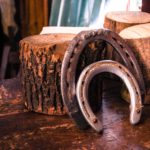
Large and small horseshoes – Photo by Jeff Smith for Unsplash
Thanks to Meg’s, I had an assortment of horseshoes, all of them full sized and well worn. I placed them around a cast iron cauldron to symbolize the power created in a blacksmith’s forge. During the ritual, each person chose an image of a horse, sight unseen, from a basket of pictures. There were farm horses, carriage horses, circus horses, show horses, war horses, winged horses, fairy tale horses, pink ponies, unicorns, and more.
We spent a little time talking about the qualities of the horse on the picture we’d chosen. Then I asked everyone, men and women, to talk about their first experience driving a car, today’s version of the horse. Some women recalled being eager to drive, some apprehensive. One man talked about the status symbol of being sixteen and having his own wheels. We talked about the need to care for a car and to maintain it properly. We talked about fancy options and horrific accidents. Each scenario related in some way to how we experience our personal power.
It takes courage to tell our stories. A story might reveal failure, loss, vulnerability, regret. But there is magic in the telling for in recounting the tale, a story might also reveal the gift of experience, achievement, wisdom, joy. It is said that one of Brigid most valuable gifts is that of imbas, the power of perception.
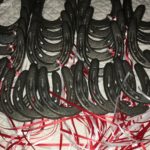
Horseshoes decorated with red and white ribbons, ready for transport to the festival of Imbolc
The tangible reward for telling a story about power was a small horseshoe, a pony shoe, decorated in red and white ribbons, Brigid’s colors of fire and ice, blood and milk. To further empower the bond created in the ritual, I took a moment near the end and gathered everyone together. We huddled in a circle, arms outstretched, holding our horseshoes, ribbons streaming from our fingers. Just as you might clink glasses in a toast, we made sure our horseshoes all touched. We celebrated courage, power, and shifts in perception.
My own horseshoe now sits on my desk, a strong and colorful reminder that what has been stirring underground for months is about to surface. Can you feel the power of the season? Can you feel your own power? Are you open to a change of perception?
Rituals keep us oriented to the natural world. That’s what this Imbolc ritual was all about. Rituals deepen the connection to our own inner world. That’s what the root vegetable ritual was all about. A ritual can be as simple or as substantial as you want. The only ingredient you really need is intent.

